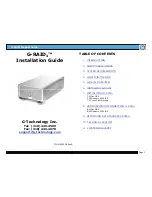
Solutions
Tier relocation
operations
Status of fixed
monitoring information
used in tier relocation
Status of data
collection in progress
Monitoring
information or
execution conditions
After recovering the
faulty area, relocate tiers
again.
1
Suspended.
No effect on the fixed
monitoring information.
The monitoring
information collected
Continued.
When an LDEV is
blocked. (Pool-VOL or
V-VOL)
during the previous
cycle continues to be
valid.
Add pool-VOLs, then
collect monitoring
Suspended.
No effect on the fixed
monitoring information.
Continued.
When the depletion
threshold of the pool
information and relocate
tiers again.
1
The monitoring
information collected
during the previous
is nearly exceeded
during relocation.
cycle continues to be
valid.
Unnecessary. The
relocation is performed
Suspended.
The monitoring
information collected
At the end time of
execution cycle, data
monitoring stops.
When execution mode
is
Auto
and the
execution cycle ends
during tier relocation.
automatically in the next
cycle.
before monitoring
performance stops is
valid.
Collect the monitoring
information again if
necessary.
1
Continued.
The monitoring
information collected
before suspension is
valid.
Suspended.
When execution mode
is
Manual
and 7 days
elapse after
monitoring starts.
Notes:
1.
The execution mode is Auto or the script is written in manual execution mode, information is monitored again and
tiers are relocated automatically.
2.
The volume is monitored at the time of the next execution cycle.
3.
All pages of the S-VOLs are not allocated, and the monitoring information of the volume is reset. After the page is
allocated to the new page, the monitoring information is collected.
4.
Example: Pool-VOLs of SAS15K are added to the following configuration 1
•
Configuration 1 (before change): Tier 1 is SSD, Tier 2 is SAS10K, and Tier 3 is SAS7.2K.
•
Configuration 2 (after change): Tier 1 is SSD, Tier 2 is SAS15K, and Tier 3 is SAS10K and SAS7.2K.
5.
The monitor information statuses are valid (VAL), invalid (INV), and calculating (PND). See
. In this case, the monitor information is invalid (INV). If monitoring is in continue
mode, the information of the mode is discarded.
6.
After completion of the pool-VOLs deletes, the monitor information status is changed from invalid (INV) to calculating
(PND). After completion of calculating, the monitor information status is changed from calculating (PND) to valid
(VAL).
Buffer area of a tier
Smart Tiers uses buffer percentages to reserve pages for new page assignments and allow the tier
relocation process. Areas necessary for processing these operations are distributed corresponding
to settings used by Smart Tiers. The following describes how processing takes place to handle the
buffer percentages.
Buffer space:
The following table shows the default rates (rate to capacity of a tier) of buffer space
used for tier relocation and new page assignments, listed by drive type.
Total
buffer area for new page
assignment
buffer area for tier relocation
Drive type
2%
0%
2%
SSD
10%
8%
2%
Non-SSD
86
Configuring thin provisioning
















































